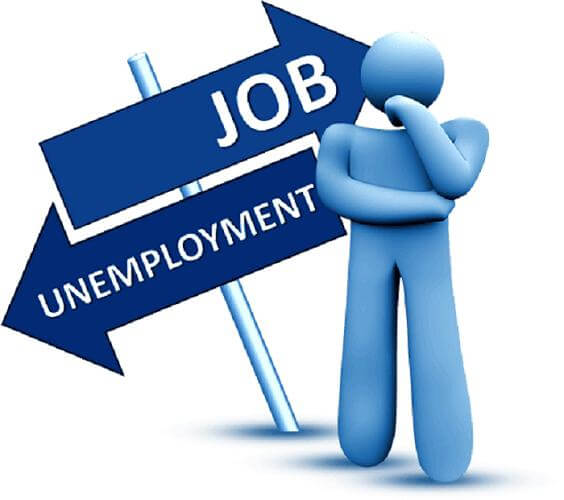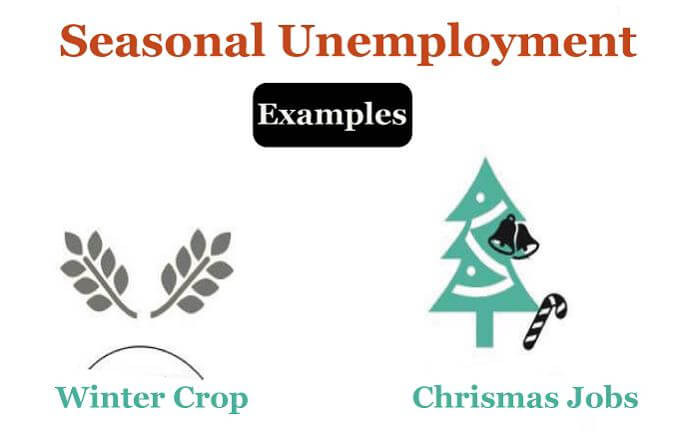What is the difference between Disguised Unemployment and Seasonal UnemploymentWhat is Unemployment?When a person is actively seeking a job but is unable to find one, this is referred to as being unemployed and this phenomenon of joblessness is called unemployment. Unemployment is a very important and most common indicator of the state of the economy of a country. It is computed by dividing the total labour force by the number of jobless people. 
Main points
Knowing about UnemploymentUnemployment shows if the employees in a country are able to find a suitable job for themselves and contribute to the economy's productive output or not. Thus, unemployment is a crucial economic statistic. The more unemployed workers in an economy, the lower is overall economic output. 
One should always keep in mind that those who quit labour for reasons such as retirement, higher education, and disability are not included in the definition of unemployed. Extremely low unemployment, however, can also be a warning indication of an economy that is overheating, inflationary pressures, and difficult conditions for businesses that need to hire more employees. Different types of employmentAlthough there is a clear definition of unemployment, there are other classifications used by economists. Voluntary unemployment and involuntary unemployment are the two broadest categories. When someone leaves their work voluntarily in search of new employment, it is said that they are experiencing voluntary unemployment. When it's involuntary, someone got fired or laid off and now needs to hunt for new work. Unemployment typesThere are four types of voluntary and involuntary unemployment. Intermittent unemployment Typically, this kind of unemployment is transient. Additionally, it presents the fewest economic challenges. When people freely shift jobs, it happens. Finding a new career normally takes some time after leaving a firm. Similar to graduates, those who are only now beginning to hunt for employment contribute to frictional unemployment. The fact that market procedures take time and that knowledge might be expensive is a natural outcome that leads to frictional unemployment. It takes time and effort to look for a new job, acquire new employees, and match the right employees with the right jobs. Frictional unemployment is the effect of this. Periodic unemployment Cyclical unemployment is the variance in the labour force's unemployment rate over the course of economic ups and downs, such as those resulting from shifts in the price of oil. During recessions, unemployment increases, while during times of economic expansion, it decreases. One of the main goals of studying economics and the many policy instruments used by governments to stimulate the economy during recessions is to prevent and reduce cyclical unemployment. Permanent unemployment A technical shift in the economy's structure, where labour markets are located, causes structural unemployment. The workers who are displaced from jobs that are no longer necessary as a result of technological advancement may become unemployed. Examples of such developments include the automation of production and the substitution of automobiles for horse-drawn transportation. These employees may require challenging, expensive, and time-consuming retraining. Workers that are displaced frequently wind up either being out of work permanently or experiencing prolonged unemployment. What is disguised unemployment?
When a portion of the labour force is either unemployed or working redundantly to the point where productivity is nearly zero, this is known as disguised unemployment. The only factor that has no impact on total output is unemployment. When productivity is low and there are too many workers trying to fill too few positions, a disguised unemployment problem exists in the economy. Major points
Recognizing covert unemploymentIn emerging nations where there is a surplus of workers and due to their big populations, disguised unemployment is a common occurrence. It can be distinguished by low productivity and frequently coexists with agricultural labour markets and informal labour markets, which can both absorb significant amounts of labour. Any population group that is not working to its full potential is considered to have concealed or hidden unemployment, which is frequently not included in official unemployment figures for the country's economy. Any group that is not actively seeking employment but is capable of performing valuable work can fall into this category, as can those who are working far below their capabilities, those whose positions offer little overall value in terms of productivity, and so on. Another approach to thinking about people who are actually working but not very effectively is to suggest that they are employed. They are underutilizing their skills, working occupations that do not match their abilities (perhaps as a result of a market inefficiency that does not recognise their abilities) or working sporadically in comparison to their ideal level of employment. Different types of disguised unemployment exist, including those who work in positions that are beneath their level of expertise, underutilised workers who are ill or disabled but still capable of contributing, and job seekers who become discouraged by their inability to find employment and give up looking for it. Several forms of disguised employment
Those who work part-time jobs occasionally may be considered disguised as unemployed if they want and are able to work full-time jobs. It also covers those who accept jobs that are significantly below their level of expertise. Under these circumstances, "underemployment," which refers to people who are working but not fully, may also be used to describe disguised unemployment. A person with an MBA who accepts a full-time cashier position because they can't find work in their industry, for instance, may be deemed underemployed because they are using their skills in a lower-wage job. A person who desires to work full-time but is only employed part-time in their sector may also be considered underemployed.
Those who are ill or are regarded as partially disabled may also be included. Despite the fact that they might not be working directly, individuals nevertheless have the potential to contribute to the economy. In the case of illness, this type of covert unemployment is temporary and is recognised when a person is receiving disability benefits. This indicates that the individual is frequently excluded from a country's unemployment statistics.
For whatever reason, after a person ceases seeking work, they are frequently no longer regarded as unemployed when the unemployment rate is being calculated. To be considered unemployed in many countries, a person must be actively looking for work. Whether temporarily or indefinitely, if someone stops looking for work, they are no longer taken into account until they start looking again. When someone is actively seeking a job but has given up hunting after becoming discouraged by a protracted search, this may qualify as disguised unemployment. Having seasonal employment might present interesting chances to operate in unique locations and carry out tasks that are related to a particular season of the year. Those who work exclusively in seasonal occupations may experience unemployment after a job's season ends because seasonal jobs often only exist during a specific time of the year. To prepare for the duration of a seasonal job and make plans for what to do after a seasonal opportunity ends, it can be useful to understand how seasonal unemployment functions. What is a seasonal employment?Any position that is only available for a certain period of the year is considered a seasonal job. During the holidays, there are a lot of seasonal jobs available because themed attractions and events go up and require workers. Additionally, there are seasonal jobs that are related to the weather, such as tourism or agriculture. These positions may entail customer service, sales, performance, and manual labour tasks. You can locate seasonal jobs with full-time hours in addition to the many seasonal positions that only offer part-time employment. Following are some instances of seasonal employment:
What is seasonal unemployment?When people experience unemployment during specific seasons of the year when there is a lower-than-normal demand for labour, this is known as seasonal unemployment. This usually happens when a certain season ends or a new one begins, for a holiday or because of weather changes. For instance, a summer resort employee may find themselves jobless once September rolls around and the facilities are forced to close. 
In areas with high tourist traffic, seasonal unemployment is common since various tourist attractions may cease or scale back activities according to the season and time of year. This is especially true for outdoor tourist sites that may only be open under specific weather conditions. How does seasonal unemployment function?The way seasonal unemployment works is to make sure that, depending on the time of year, the number of jobs available matches the demand for workers in a company. Hence, a company might require more workers during some seasons than during others, which could lead to a temporary increase in unemployment once the busier season ends. When there is seasonal unemployment, workers who hold jobs that are directly related to a certain season or event are let go and forced to look for new employment possibilities. Some people switch to a new seasonal job every time a season changes in order to continue working seasonally and swiftly locate employment as a response to seasonal unemployment. For instance, in a ski resort, it's likely that unemployment is higher in the summer when there isn't any snow. Due to the increased jobs that are available around Christmas, unemployment rates frequently decrease (e.g. Royal Mail taking on extra workers for mail delivery) Because jobs are only accessible for a few months out of the year, seasonal unemployment could be a major issue in tourism destinations. In what ways is seasonal unemployment a problem?
Seasonal unemployment solutions
Disguised unemployment differs from seasonal unemployment in that more individuals are employed than is necessary when it comes to specific seasons of the year, whereas seasonal unemployment results in a lack of appropriate jobs for people. There are two different sorts of unemployment: seasonal unemployment and covert unemployment. When qualified people cannot find blooming occupations paying a living salary, they are unemployed. Urban areas experience educated unemployment, whereas rural places experience seasonal unemployment. Key differencesThis is a comparison of the key differences between disguised unemployment and seasonal unemployment: Seasonal Unemployment
Disguised Unemployment
The distinction between hidden unemployment and seasonal unemployment is that during specific seasons of the year, there is a dearth of suitable employment for people. Contrarily, disguised unemployment occurs when more people are working than is necessary. ConclusionUnemployment is a threat to economy and government should employ various ways to cope up with the increasing rates of unemployment in order to maintain a healthy economy. Both seasonal as well as disguised unemployment are a major problem in nations with high population such as India.
Next TopicDifference between
|
 For Videos Join Our Youtube Channel: Join Now
For Videos Join Our Youtube Channel: Join Now
Feedback
- Send your Feedback to [email protected]
Help Others, Please Share










